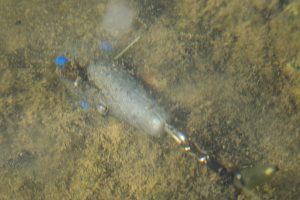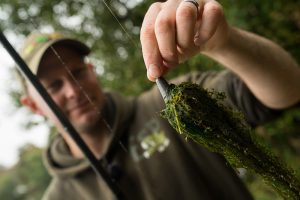‘Watercraft’. A single diverse word that means so many different things to anglers and very little to non anglers. In fact if you looked up the word Watercraft in a carp dictionary there simply wouldn’t be enough pages to thoroughly explain the meaning.
'Watercraft' - a single, yet diverse word that means so many different things to anglers
Anglers who begin to understand watercraft catch many fish. Anglers who are experts in watercraft still have a lot to learn. Watercraft evolves from one year to another on any given venue and has a totally different set of variances between different waters.
For now I am going to take a look at one small piece of the watercraft jigsaw and explain my process of feature finding and more importantly finding and hitting the right spot. The style of angling that I often adopt (3 on a spot) relies very heavily on finding the right spot. When putting all of your eggs in one basket you have to be sure that you have found the right basket to start with. Fail on the first hurdle and a blank will more than likely be on the cards.
The first time I fish a swim I will spend a fair amount of time with a lead and marker set up building up a strong picture of the depths, weedy areas and more importantly the clear spots. Nowadays this process can be fast tracked with the aid of a deeper fish finder which can mark all of the depths of a swim with pinpoint accuracy in just four or five casts. I have to admit I have used one a few times in the depths of winter to quickly build up a picture of the contours of a lake, a lap of the lake with a few casts in each swim will put you in good stead for that venue. However I very rarely if ever use the deeper again the rest of the season.
Anglers who begin to understand watercraft catch more fish
Once set up in a swim for the first time I will spend some time casting around with a bare lead to look for clearer harder areas. I will normally do this of an afternoon after the main bite time has passed as not wanting to ruin other anglers chances with excessive casting. I will cast as many times as I need to until I find what I feel is the perfect spot. I love fishing weedy waters as it makes it so much easier to figure out the spots where the fish have been feeding. Sometimes it may take me 100 casts to find a small clear spot or sometimes it is a case of casting at the tallest tree on the horizon and the lead will go down with a donk. Once I get a drop with a bare lead whilst using a braided mainline, I will clip up and then switch to a sea fishing gripper lead with the 4 prongs sticking out. Then I will re-cast to the same spot, lining it up with a far bank marker. I will then slowly drag the lead back with the tip down. The less resistance felt, the cleaner and harder the spot will be. If met with a solid resistance then you know you are in weed. Once the lead has been dragged back a rod length or so I will whip the lead up off the bottom and wind in quickly and once the lead is out of the water I will inspect the prongs on the lead to see if there is any weed, debris or even bloodworm on the prongs. In an ideal scenario I am always looking for a hard drop and a very clean smooth drag back, especially if the spot is surrounded by weed. This simply cries out ‘carps dinner plate’. Once I have found the dinner plate I will clip up and cast to the left and right to explore the boundaries of the spot. I want to figure out which part of the spot gets the hardest drop, the cleanest drag back and how far left or right I can cast and still land on the spot.



Once Kev has found a great spot he goes to work with a sea gripper lead. Inspect the prongs and keep notes!
On many occasions there simply will not be a perfect little clear hard spot out there surrounded by weed and on these occasions I try to find as light weed as possible. By fishing particle baits over the top it is possible to get the fish to polish the spot off and create a new spot. Regular baiting will help but the biggest challenge is to get them feeding in the first place and get that first bite. In my experience the cleaner spots are far easier to get bites off to start with but getting a spot polished off your self can be far more satisfying.
Once I have found my chosen spot, I will use a far bank marker for direction and then wrap my marker lead round wrap sticks to measure the exact distance making a note in my carpy diary for future reference. It may take me 50 casts that first trip but once mapped out and etched into the diary it makes life simple for future sessions.
The next thing to consider is the distance to clip the spod rod compared to the fishing rods. I use a fairly simple equation. My fishing rods are clipped up to exactly the same distance as my marker rod. Then I clip my spod rod up shorter than my fishing rods depending on depth to allow for the fact that my rigs will swing back towards me as they fall through the water on a tight line. The equation is simple. For every two foot of depth of water, I clip up my spod rod one foot shorter than my fishing rods. So for example if I were fishing at 20 wraps and it was 14 foot deep, I would clip my spod rod 7 foot shorter than my rigs.
So I have found a lovely little clear area and my rods are clipped up. If I feel confident that I am on fish and they are up for some grub. I will introduce anywhere between three and six kilos of particles which is normally made up of hemp, sweetcorn and 10mm live system. I like to give them enough bait to try and instigate competitive feeding. A situation that is very easily achieved the higher the density of stock but can also be achieved on lower stock venues too.
The equation is simple: for every two feet of depth, clip up your spot rod one foot shorter than the fishing rods
Once I have baited and set my traps, I will only top up once I have had a bite. It really is a case of kicking back, sitting and waiting. I am not a fan of the little and often theory; I like to put a decent bed of bait down to start with and sit on it. If no bites occur then I do not put any more bait in. If I do get a bite or two then I like to top the swim up with more bait to replenish the bait that has been eaten. I always want that spot to have bait on it so whenever a carp comes along there will always be enough bait there to temp it to feed. In general I tend to top up with around 10 spombs after every fish but sometimes I will put out more if I feel the conditions are right and a hit is on the cards or sometimes I will put out less if I think that bite time is coming to an end and I feel there is a chance of nicking another quick bite. Watercraft and intuition will tell you how much to top up and this comes from putting the time and effort in and always learning from every trip.
Unlike many anglers, Kev prefers to give them a big hit of bait rather than feed little and often
There is nothing instant about carp fishing, it can only be learned over time from putting in the effort and experimenting. Once you think you have learned all you can from a venue, it is time to head to pastures new and start the whole process of learning again from scratch. The more times you repeat this process the easier it becomes.
Tight lines, Kev Hewitt
...and it works!
Archives
Categories
Recent Posts
- E-S-P April Product Launch 2024!
- E-S-P July Product Launch 2023!
- A Tricky Autumn Comes Good – Kev Hewitt
- Carp Team England Wins Gold!
- Barry Hearn Masterpiece!
- E-S-P July Product Launch 2022!
- Kev Hewitt – A Golden Ticket
- Kev and Bart cruise to the BCAC Semi Finals
- Fishing is the best medicine – Darren Blunt
- A Trip To The Country – Alfie Russell
- Paring it down – Dave Ellyatt
- Daren Norman – Burghfield Challenge
- Daren Norman – Long awaited Cassien trip!
- Decluttering: Back To Basics with Alfie Russell
- ESP’ New Ronnie Clips: Inception to Finished Product
- Kev Hewitt’s 50th UK 40lb Carp!
- When it all comes good – Alex Grice
- Liquid loading your bait – Tom White
- Watercraft: The whys and wherefores – Kev Hewitt
- The Development of a Carp Hook – Dave Ellyatt




